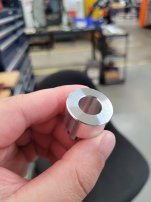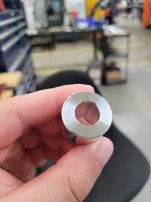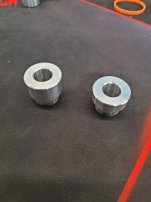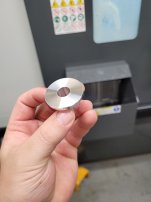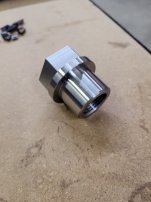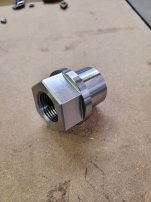Dylan @ FDF
Plastic
- Joined
- May 11, 2023
I have used PM for a few years searching through and usually finding the right answer for my issue.
Today I have come across an issue I just can't seem to remedy. I have about 20 hours of troubleshooting into it at this point, I will keep it as short and sweet (as possible)
Machine: ST15 and ST20Y(same results either machine)
Coolant: Trim Microsol at about 10%
Tool: Iscar Tang grip/IC20 insert
I will attach some photos, it is a finish I have seen a few people fight against. The typical golf ball/smearing in 6061 and then chatters as you increase SFM.
The important thing to note here - Our ST15 has run about 22000 6061 parts with the above combo, with very little adjustment needed to SFM to keep a satisfactory finish on the parted face for no 2nd OP. This started with a fresh batch of 6061, however I ordered more material from another supplier who uses Canadian mills(we are in Ontario) and I didn't get anywhere, it was the same awful finish using proven program parameters, with no improvement after playing around as I typically would.
Things I have tried:
SFM/Feed in every variable from 200sfm to 1200sfm and .0006ipr to .007ipr - note that it gets much worse with increased feed. Typical parameters run are .0013 to .0018ipr at 350 to 600sfm depending on batch of material and insert sharpness.
New blade(as we just purchased the ST20Y and ordered fresh tooling) to rule out insert seat damage or fractures
Square of holder, checked runout in Y and X for the blade holder on the 20Y, no concerns there.
Part off insert to centerline(.001 or slightly less)
Coolant pressure and % is as usual for the previous 20k parts
Always back parting, leaving anything from .0015" to .025" for finish pass.
Changed chuck pressure between basically anything safe to operate at
Tried G96 and G97 for parting, sometimes I run G96 with a low ipr to finish bushings that leaves a satisfactory finish.
Worth noting that the facing and boring operations have no issues, it is just parting this material off that has been a fight.
Setup the same tooling and material on the new 20Y and used the same program and got identical parting finish, trying to rule out any issues with the ST15 itself. I can also mostly rule out the machine and tool mostly through the fact that we can run 4140 with the same blade and different insert grade and the parts turn out as good as you could want them to. Also ran 303 stainless last week in between troubleshooting and it ran just as it always does.
At this point, I would love for it to be as simple as I got a bad batch of 6061, and when I ordered the stuff from the next supplier it was also garbage. But maybe I am missing something here? I'm just stumped as this tool setup has been very very consistent for a year and a half running lots of nice looking parts.
Order of photos - running at the normal parameters, running higher feed(as feed goes up, finish looks worse, as sfm goes up, chatter intensifies) larger material(1.25" stock, first photos are from 1" stock) using the proven parameters, 4140 running on the same lathe with the same tool/holder and IC908 insert, and final photo is typically the finish we are achieving in 6061.
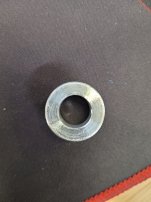
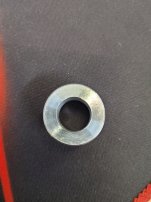
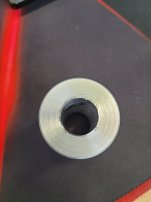
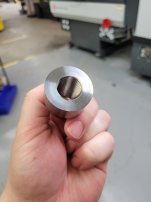
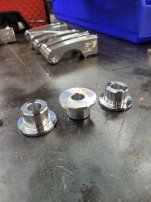
Any insight is appreciated!
Today I have come across an issue I just can't seem to remedy. I have about 20 hours of troubleshooting into it at this point, I will keep it as short and sweet (as possible)
Machine: ST15 and ST20Y(same results either machine)
Coolant: Trim Microsol at about 10%
Tool: Iscar Tang grip/IC20 insert
I will attach some photos, it is a finish I have seen a few people fight against. The typical golf ball/smearing in 6061 and then chatters as you increase SFM.
The important thing to note here - Our ST15 has run about 22000 6061 parts with the above combo, with very little adjustment needed to SFM to keep a satisfactory finish on the parted face for no 2nd OP. This started with a fresh batch of 6061, however I ordered more material from another supplier who uses Canadian mills(we are in Ontario) and I didn't get anywhere, it was the same awful finish using proven program parameters, with no improvement after playing around as I typically would.
Things I have tried:
SFM/Feed in every variable from 200sfm to 1200sfm and .0006ipr to .007ipr - note that it gets much worse with increased feed. Typical parameters run are .0013 to .0018ipr at 350 to 600sfm depending on batch of material and insert sharpness.
New blade(as we just purchased the ST20Y and ordered fresh tooling) to rule out insert seat damage or fractures
Square of holder, checked runout in Y and X for the blade holder on the 20Y, no concerns there.
Part off insert to centerline(.001 or slightly less)
Coolant pressure and % is as usual for the previous 20k parts
Always back parting, leaving anything from .0015" to .025" for finish pass.
Changed chuck pressure between basically anything safe to operate at
Tried G96 and G97 for parting, sometimes I run G96 with a low ipr to finish bushings that leaves a satisfactory finish.
Worth noting that the facing and boring operations have no issues, it is just parting this material off that has been a fight.
Setup the same tooling and material on the new 20Y and used the same program and got identical parting finish, trying to rule out any issues with the ST15 itself. I can also mostly rule out the machine and tool mostly through the fact that we can run 4140 with the same blade and different insert grade and the parts turn out as good as you could want them to. Also ran 303 stainless last week in between troubleshooting and it ran just as it always does.
At this point, I would love for it to be as simple as I got a bad batch of 6061, and when I ordered the stuff from the next supplier it was also garbage. But maybe I am missing something here? I'm just stumped as this tool setup has been very very consistent for a year and a half running lots of nice looking parts.
Order of photos - running at the normal parameters, running higher feed(as feed goes up, finish looks worse, as sfm goes up, chatter intensifies) larger material(1.25" stock, first photos are from 1" stock) using the proven parameters, 4140 running on the same lathe with the same tool/holder and IC908 insert, and final photo is typically the finish we are achieving in 6061.





Any insight is appreciated!


